#moko text
Text
(fengqing / nsfw text??) my headcanon
i talked about it on twitter too, but in my head, fx is the type of bf who is just happy to be together (bc all the ju yang rumors make him uncomfortable) but mq is hornier than him and always touching when theyre alone
when they first got together, i think fx wants to take it slowly and doesnt really care either way but mq is like. I need him on top of me now (has been pining for ages)
i don't think fx would casually hook up with anyone bc he is incapable of not fully committing to relationships and i dont think he can enjoy 🔞🔞 for the sake of it unless he feels super comfortable or emotionally close with the other person, bc hes just a guy that ppl keep making weird comments about
i think that fengqing when dating have had a serious fight over the ju yang jokes at least once!!
both of them get jealous and possessive over the other but i think mq is worse because of reasons.
178 notes
·
View notes
Photo





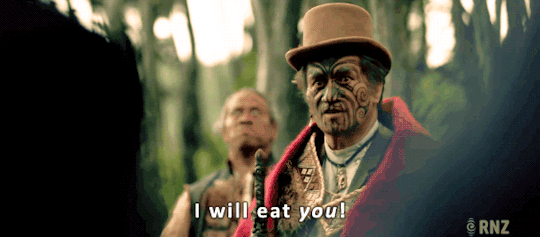
[image description: 6 gifs stacked vertically. The gifs depict a Māori leader, Pōtatau Te Wherowhero, and Governor George Grey, engaging in a tense conversation. The first gif features Grey in a gray and Black suit with a top hat, with two soldiers behind him, in a green forest, the text reads, “What will you eat?”. The second gif features Te Wherowhero opposite to him, wearing a brown top hat, a traditional cloak along with a red blanket, holding a taiaha, and with moko on his face, another warrior behind him: the text reads, “we will eat mamaku, para. We will be sustained by the fruits of our forest”. The third gif shows the camera move back to Grey, with a smug expression, the text reads, “and when that food is gone, what will you eat then?”. The fourth gif depicts Te Wherowhero again, looking away briefly before turning to Grey with an intense expression, and motioning to him with his staff, with the text that says “you!”. The fifth gif is back to Grey, the smug expression gone from his face and replaced with horror as his eyebrows furrow. The last gif is of Te Wherowhero again, both he and his warriors with a fierce expression and widened eyes, Te Wherowhero motions with his staff again more forefully, the text reading “I will eat you!”. End image description.]
#saw this and I had to gif it#justin's edits#maori#Te Wherowhero#NZ Wars: Stories of Tainui#historyedit#history
371 notes
·
View notes
Text
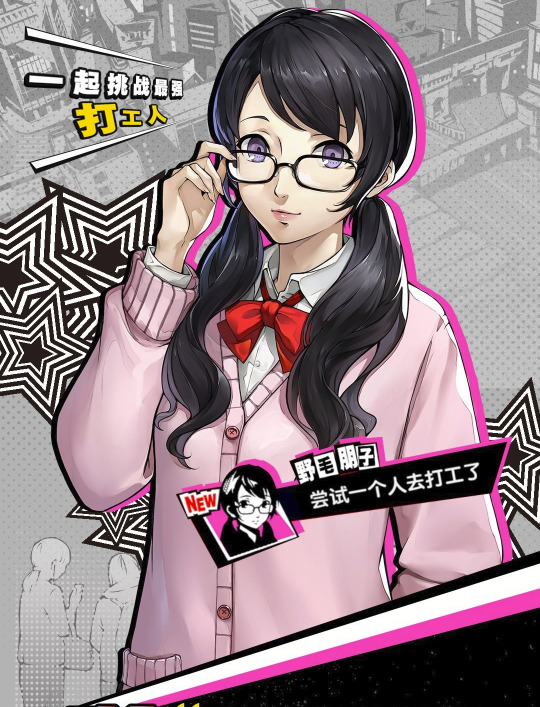



What We Know About Moko
(as of the third beta; last updated 1/23/24!)
Tomoko Noge, codename Moko, is a second-year at Kokatsu Academy in class 2D. She and her best friend, Motoha Arai in class 2C, both have an interest in playing baseball, and were in a little league together when they were younger. She joins the team as a "Phantom Idol", or cognitive teammate.
Previously, in the second beta, her codename was “Kotomo”, however it was changed to Moko in the third beta.
Her Japanese voice actress is Satomi Akesaka.

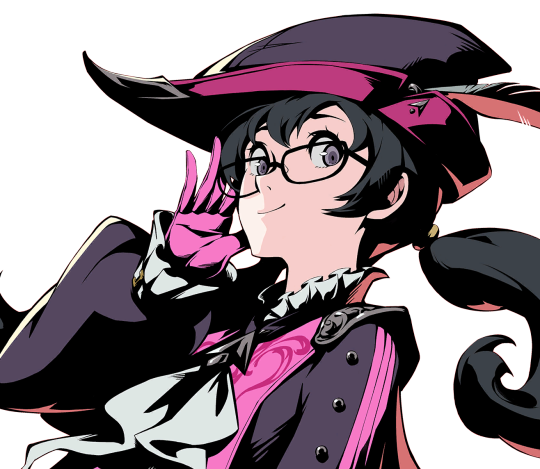


Tomoko is a Confidant of Wonder's, though her Arcana is unknown.
Tomoko is first relevant in the plot when Wonder sees she dropped her train pass and returns it to her, though then continues to be relevant as Motoha's friend who gets scouted for some sort of baseball thing. She also develops a bit of a crush on Wonder, to her own admittance.
However, shortly after Wonder and Ruferu begin exploring the first Palace, belonging to Takeyuki Kiuchi, the real-world Kiuchi sees Motoha and Tomoko at the train station and attempts to attack Motoha. Tomoko sees what he's doing, and takes the blow for Motoha, getting knocked over the guard rail and onto the train tracks. She ends up needing to be hospitalized.
Her injury means she can no longer play as a baseball catcher, which causes her to become extremely dejected and hopeless during her hospital stay, to Motoha's dismay. This ends up motivating Motoha to agree to changing Kiuchi's heart, despite the possible risks involved.
Correlating with when Wonder, Motoha, and Ruferu open the next area of Mementos, she mentions suddenly feeling the desire to do something, and returns to school after Kiuchi's change of heart and recovering from her injuries.
Tomoko's role seems to loosely parallel Shiho's in the original P5.


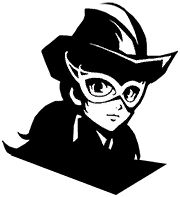
Tomoko is quieter than Motoha, but not to the point of shyness, and no less passionate about baseball. She has little difficulty approaching the protagonist and talking to him despite her crush (though she does get nervous when Motoha more directly tries to push her towards Wonder), and works part-time jobs with him during her Confidant, trying to figure out what to do now that she can't be a baseball catcher like she wanted.
She also doesn't seem insecure about her role as Motoha's friend, though we haven't really seen her interacting with anyone besides her and the protagonist. She jokingly apologizes to Wonder for "stealing" Motoha at one point when Motoha drops everything to visit her, instead of Motoha's original plans with Wonder (visiting Takemi for the first time).
When the "Flavor Fight" video is posted, she texts Motoha that her classmate Shun didn't come back to their classroom after lunch, suggesting Motoha may be keeping Tomoko at least slightly in the loop about what Motoha's up to, though there's been no indication that Tomoko knows about what they're doing as phantom thieves. This also suggests Tomoko has a good awareness of her surroundings.
This is supported by her profile, which has been translated as "She has a calm personality, outstanding observation skills, and is used to taking the initiative to take care of those around her. As a baseball catcher, she won various championships with Motoha when she was young, and she is full of confidence in her strength on the field."

Her Persona is Prosymna (based on a naiad who nursed Hera, alongside her sisters), and has Psy skills, a status effect skill, and a support skill, resisting Psy while being weak to Curse in the third beta.
In combat, her melee weapon is twin daggers, while her ranged weapon is a bow. Her highlight attack is shown from 0:09 - 0:20 in this video.
23 notes
·
View notes
Text
A Friendly Reminder that Giyuu is Very Attractive in Canon! - an updated post
So I was the one who made the Attractive Giyuu post before, but looking back, it was a mess, and some of the wording was inaccurate, so I reposted it with proper credits to the original poster and better wording. Many thanks to @demonslayedher for helping me look and translate the text on the source material. (which helped me understand these information in a much better light) Anyways, on to the post!
1. It's canon that Giyuu has Strong Eyeliner Game. In the first fanbook, it was said that Gotouge apparently draws him with "thick lashes". The way his eyes are drawn, "the upward curve at the bottom outer edge" is done to make him look more “ikemen” and ikemen means “hot guy”
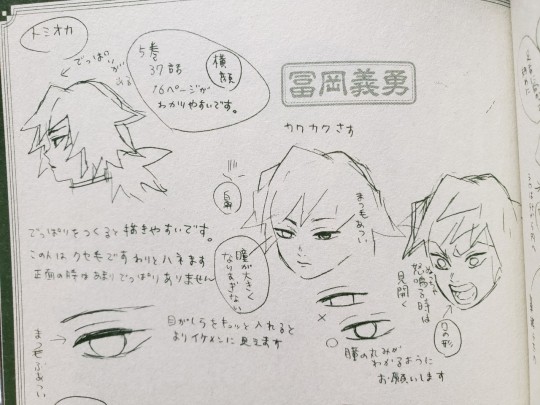
2. HE IS POPULAR! In the first fanbook and Kimegakuen special, Giyuu got 31 chocolates, the second highest out of the three other popular teachers such as Rengoku and Uzui. Even if Giyuu may not be well liked by some of his peers, it's safe to say he might have many admirers among the students!

3. The fact that he is voiced by Takahiro Sakurai is no coincidence! He is a seiyuu that is very popular for voicing handsome characters (or those marketing to be more attractive, I'm looking at you Reigen)

Sakurai-san is certainly not limited to handsome characters, he has incredible voice range after all, but the voice he uses for Giyuu tends to be the one he does for "Ikemen" Characters. Some of the "handsome/cool" roles he played includes: Cloud strife, Makishima Shougo,Yamato Kurosawa and Albert Hawke, Griffith from Berserk, Su from Honkai, Merlin from FGO, just to name a few. (He also did a lot of BL roles but we will not get into that)
4. Light Novels, Uzui (indirectly) calls Giyuu handsome.

In this chapter, Uzui encounters a wild smiling!Giyuu, what he doesn’t know was that this is actually not the true Giyuu but rather, a ghost impersonating him. nonetheless Uzui's POV off handedly mentioned how this cheerful Giyuu looked handsome.
Check out Moko-chan's translations on Wordpress, for full context go check out the third Light Novel: Chapter 5 Kimetsu Academy Tales ~ Night Stroll
5. In the KNY Exhibit “The Legend of Zenitsu”, Zenitsu drew three people that he hated for being close to Nezuko, Brother-in-Law (Tanjiro), Pork Tonkatsu (Inosuke) and the Ugly Side Character TO-MI-O-KA (Giyuu).
You can check out mimizili's twitter for the pictures, there is a description, and It’s hard to really make it out, but thanks to @demonslayedher what she was able to understand is that The uglier Zenitsu’s drawings were, the more of a “slender pretty type boy” they are in real life, and it’s safe to say Zenitsu’s drawing of Giyuu was the ugliest of the bunch.....
(as for the "slender pretty boy" its worth noting some of the specific words that are used such as "シュッとした/shuttoshita" which is a slang for someone with slender build and "美男" which means “beautiful man" all which heavily alludes to Giyuu in one way or another)
So yeah! Giyuu is canon beautiful, that's it, that's the post.
#kny#kimetsu no yaiba#demon slayer#tomioka giyuu#giyuu tomioka#hashira#uzui tengen#tengen uzui#zenitsu agatsuma#meta#analysis#my post#takahiro sakurai#I got the idea for this post when I saw someone talk about aots eren being canon handsome#and im like yeah time to use my phd in giyology
469 notes
·
View notes
Text
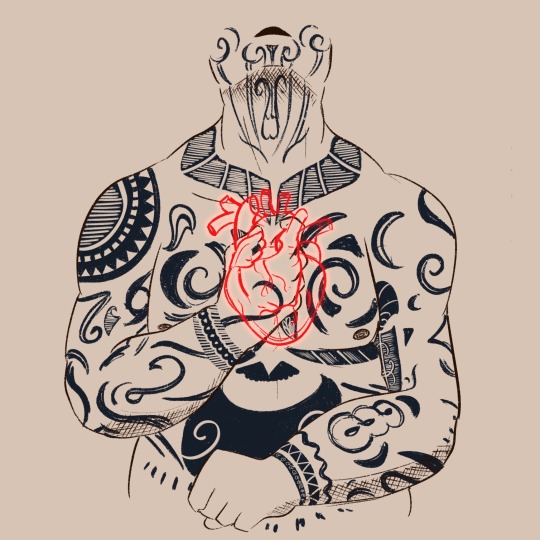
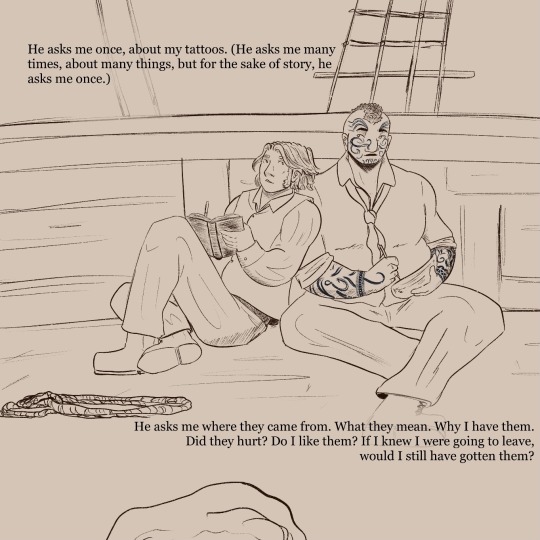

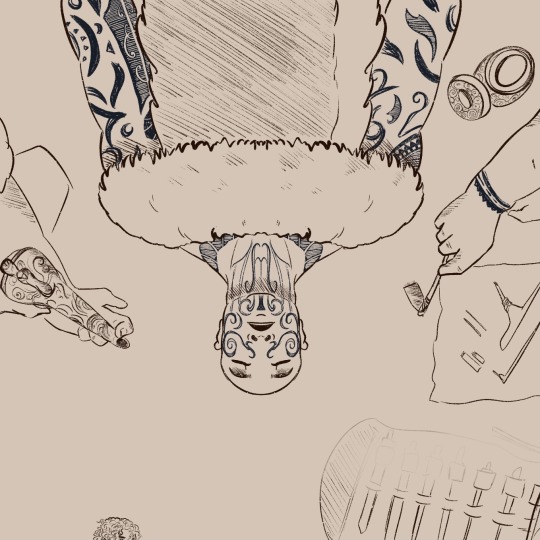
made a comic about queequeg, tattoos, queerness, and identity. originally for my class on the history & cultural practices of tattooing. you can buy the whole thing for $5 on pocketsizedquasar.itch.io! includes 9 pages of lined art, the title page, an artists statement, n a further reading/works cited list
(ID: several digital line drawings of a comic about queequeg from moby dick. they are a muscular māori person with their skin covered in tattoos, and their short curly hair in a topknot. the first image shows him and his tattoos with a red anatomical heart over his body and hands. the second is of ishmael and queequeg sitting together on the ship, with the text: “he asks me once, about my tattoos. (he asks me many times, about many things, but for the sake of story, he asks me once.) he asks me where they came from. what they mean. why i have them. did they hurt? do i like them? if i knew i were going to leave, would i still have gotten them?” the third image is of a few poses of queequeg with their face blacked out. the fourth image shows them laying on their back, receiving their face moko.)
#mobydick#moby dick#queequeg#herman melville#comic art#melville#comic#classic lit#classic literature#art#my art
122 notes
·
View notes
Text
Regret. (Random story hehe)
“Rey!” you shouted “Choi!!” your boyfriend Rey shouted back, you ran and hugged him “I miss you!!” he kissed your cheek “I mean, who wouldn't miss me?” he teased. Your boyfriend Rey was the smart and the campus crush boy in your campus, every girl had a crush on him besides from his good looking face, he had a personality that is very rare and that is his caring for you. Every time you told him that someone hurts your feelings he would not hesitate to get contact with that person to tell them on what they did to you. “Love naman ehh” you pouted “I’m just kidding naman Choi! I missed you more!!” he shouted hugging you tightly. Everyday he would send you pictures of him even if he was insecure and he did that just for you to be happy, he would be that type of person to do anything just to make you happy. TIME SKIP. It was your monthsary and when you woke up he already greeted you with his picture. You enjoyed being with him until it became the month of December, you guys kept fighting about the smallest things. One day you couldn’t handle it anymore “Rey let’s just end this already” you told him for the tenth time of this month. “Ok.” he said with no hesitation, you were shook because every time you would say that word he would reply with “No love wag let’s fix this” “Wag moko iwanan love” “Love I'm sorry” but now he changed “If you want a break up edi mag break na tayo, I’m sick of you trying to threaten me with your words! We’re over Choi” he added, He left the room and you didn’t feel anything not even a single tear shed. A few weeks later and you found out he’s dating a new girl, The girl you hated the most. You saw his posts on Instagram with his girl and you were furious with a mix of regret although you guys where just friends now. “Kamusta na Rey, It’s been a while how is Trice?” you texted him “Oh hi Choi!, I’m fine me and Trice are having a healthy relationship, How about you?” he replied I’m still single haha” you replied to him, this is where you started to regret. You saw how much he changed and how he loved his girlfriend but he never did that to you since he acted immature at the time you guys were dating. few months later you still felt that regret inside of you “Rey i’m sorry kasalanan ko to.”
2 notes
·
View notes
Text

[ ID: A screenshot of a boat message from Sky: Children of the Light. Originally written in Japanese, the in-game translation's English text reads, "Moko's Diary. Today I met a very kind person (⚪) in the meadow! Had a lot of fun playing with him! I want to play with him again! That's all". It is followed by a kaomoji with a pleasant expression. It as 40 likes. End ID. ]
4 notes
·
View notes
Text
The Amatsu Tatara

The Amatsu Tatara is an ancient collection of texts that are believed to have originated from the gods. It is composed of three books: the Kojiki, the Engishiki, and the Shinto Shogon, and is believed to be one of the oldest known texts in Japan, dating back to the 8th century AD. The Amatsu Tatara contains stories, rituals, and teachings related to the Shinto religion, and emphasizes the importance of understanding the interconnectedness of all things and of living in harmony with nature. The Amatsu Tatara is intimately connected to the concept of Ninpo, which is related to perseverance, Shinto, old-Shinto or ko-Shinto, life, survival, nature worship, and becoming a fully realized human being. The texts of the Amatsu Tatara emphasize the power of the divine and the importance of living with compassion and gratitude, and these teachings have been adopted by many Eastern Asian cultures and countries.
The Amatsu Tatara is also related to the healing aspects of Ninpo, as it encourages us to seek a balanced and harmonious life, to be mindful of our connection to the divine, and to use our understanding of the interconnectedness of all things to heal ourselves and the world around us. This ancient text provides a valuable source of wisdom and understanding, and its teachings can be used to bring balance and harmony into our lives.
*There is a Master of these ways who is not well known in the west unless you have had the privilege of running in his circles. His name is Dr. Masaaki Hatsumi, formerly Yoshiaki Hatsumi, born in Noda, Chiba on December 2, 1931. Dr. Hatsumi inherited the position of sōke (grandmaster) of nine ryū (schools of martial arts):[8][9]
-Togakure-ryū (戸隠流)
-Gyokko-ryū (玉虎流)
-Kuki Shinden Happō Biken Jutsu (九鬼神伝流八法秘剣術)
-Kotō-ryū (虎倒流)
-Shinden Fudō-ryū Dakentai Jutsu (神伝不動流打拳体術)
-Takagi Yōshin-ryū Jūtai Jutsu (高木揚心流柔体術)
-Gikan-ryū Koppō Jutsu (義鑑流骨法術)
-Gyokushin-ryū Ninpō (玉心流忍法)
-Kumogakure-ryū Ninpō (雲隠流忍法)
Among his many accomplishments, he is an eminent martial artist, an expert healer in the ways of the Amatsu Tatara, a business owner, a doctor of osteopathy, a well-known artist in multiple mediums, a calligrapher, and is proficient in theatre as well. Dr. Hatsumi Sensei has also served as a martial arts advisor for various film and television productions, including the James Bond movie "You Only Live Twice".
Dr. Masaaki Hatsumi, amongst many other publications, awards, and accolades from Japan and around the world, is the author of "Life Secrets of the Amatsu Tatara: The Documents of Takamatsu Toshitsugu, Interviews with Hatsumi Masaaki"
When Hatsumi was 26 years old, he met Takamatsu Toshitsugu, who was nicknamed Moko no Tora (Mongolian Tiger). After passing the Sakki test(5th degree/level), Takamatsu gave Masaaki Hatsumi the menkyōkaiden of the 9 Warriors Ryūha listed above. The rest of his story is for another time and maybe another place. We will tackle some more historical knowledge and contemporary musings of this incredible human being in future posts when the time is right... So for now, Be Well and Gasho!
#Healing#wisdom#quantum#japanesehealing#ancient#spiritual#spiritualhealing#spiritualawareness#awareness#kami#universe#rhodeislandmartialartscenter
1 note
·
View note
Text
The Thematic and Visual Elements of La Belle et la Bête and Pépé Le Moko
By: Julia Kusmenko
As World War II impacted Europe in the early 1900s, cinema during this time reflects the effects of German occupation and artistic styles that were influenced throughout these years. In France for example, the 1946 film La Belle et la Bête reflects the impact World War II had on storytelling and 1937 film Pépé Le Moko displays the dark mood felt during the years leading up to the war.
Regarding La Belle et la Bête, the influence World War II had on storytelling is expressed by the text from Lincoln Kirstein which reads as follows: “The French are famously frank. Four years of individual hell have sharpened their irony and released their creative energies. Their attitude towards the films at the present is wonderfully fresh, interested, responsible and honest” (Kirstein 20). As a result, the stories told were fresh since the French no longer were oppressed by German regulations in 1946. With La Belle et la Bête, this film embodies this new and creative storytelling in France as the plot incorporates fantastical house furniture that comes to life, over-the-top costumes and a living man-beast. From this, German Occupation was not able to stop the creative energies of the French, rather, it encouraged the French to express themselves creativity after years of suppression.
Regarding Pépé Le Moko, this film is about a man who is notorious for stealing among the Casbah in Algiers and avoids being caught by police. What is interesting about this film is that it presents dark tones to the audience through the mise en scène by the lighting and dramatic camera angles. The themes of this film are also dark as the main character Pépé is depressed and expresses his dissatisfaction with life by drinking and taking out his frustrations on others. Pépé’s sadness can be seen by the image of him staring off into the distance behind bars moments before committing suicide as he watches the life he could have had slip away in front of his eyes.
A quote from the reading that illustrates this dark mood in Pépé Le Moko says “the mood found in the best of these films––a mood created from the emphasis accorded certain kinds of behavior and especially from formal factors such as lighting, camera angles, iconography, mise-en-scene––may ultimately be closer than a diegetic analysis to what was really felt, and thought, during those dark years” (Greene 440). In other words, the darkness of the mood in Pépé Le Moko that is expressed through the mise en scène and visual elements of the film relates to the uncomfortable feeling experienced by French citizens leading up to World War II.
With this, “This mood appears to me important enough to constitute not only the originality and unity of many films of this era but also a recognizable style” (Greene 440). In other words, the mood present in Pépé Le Moko is indicative of a certain style that was common in films during the time period. From this, films such as Pépé Le Moko are a product of the social environment as the political climate they are produced in may influence the story’s tone and mood.
Image from Pépé Le Moko:
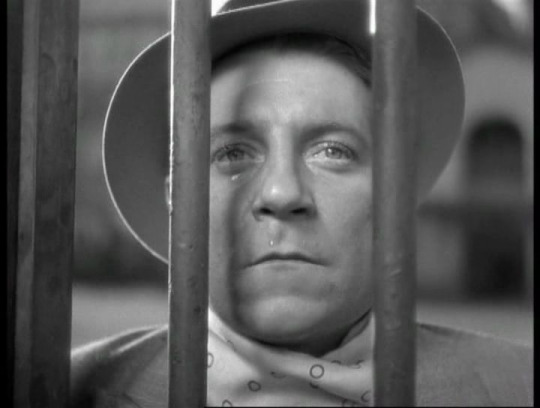
Works Cited
Greene, Naomi. “Mood and Ideology in the Cinema of Vichy France.” The French Review, vol. 59, no. 3, 1986, pp. 437–45. JSTOR, http://www.jstor.org/stable/392672. Accessed 1 Nov. 2023.
Kirstein, Lincoln. “French Films during the Occupation.” The Bulletin of the Museum of Modern Art, vol. 12, no. 3, 1945, pp. 16–20. JSTOR, https://doi.org/10.2307/4058089. Accessed 1 Nov. 2023.
0 notes
Text
Fx is the type to do aything and give the world to his lover so when he starts dating mq he would show him CONSTANTLY that hes serious about it and mq would be like ughhh youre so annoying just kiss me
168 notes
·
View notes
Text
break and pivot independant
cannot believe we had independent study to do over the break when we are simultaneuosly told to take a break and relax
okay re-reading what it says its telling me to take my time doing the independant and to not forget about it - explore at your own pace
reading is Hirini Moko Mead's Ngā Pūtake o te Tikanga: Underlying Principles and Values.
Make some notes on your understanding of tikanga, considering this in relationship to ethics and values. You will need to bring this to class for discussion in week 7.
notes from the reading;
Tikanga Maori - English doesn't do it justice but Tikanga is basically the customs and practices and all-encompassing things to do with Maori culture. for example as outlined in the text -tikanga maori is something that (for example) a ceremony must have to be correct and true to the principles and values of maori culture.
principles of tikanga maori
tika - right, correct
pono - true, genuinue (when making a judgement in terms of maoritanga)
tuturu - fixed, permament, enduring (use to emphasise a fixed and never changing practice but now meaning has changed to be more like pono)
take - a breach of tikanga
utu - recompense
ea - a state of resolution in which all parties are satisfied
manaakitanga - expected standard of behaviour - an ideal that one should aspire to reach.
value - the regard something is held to deserve; importance or worth
values - principles (holding something to be important
whanaungatanga - embraces whakapapa and focuses upon relationships.
kanihi kitea - a face seen
muru - the ritual redistribution of property
mana - authority, control, influence, prestiege, power, psychic force, effectual, binding authoritative - the place of the individual in the social group.
pono is an old idea and its meaning is free of other connotations - by focussing on pono judgement can be made about whether the practice of a particular tikanga is true to the principles of maoritanga or if it is borrowed from somewhere else (i dont know what this means).
what a spectator might observe and be told is genuine Maori culture may not pass the test of pono - so a tikanga Maori ceremony needs to be correct and true to the principles and values of Maori culture.
judgment about the application is based on whether the principles or standards of behaviour or practice have been observed adequately - so a judgment is made by assessing a range of variables
concept of take-utu-ea comprises an analytical template for examining behavioural issue. each of the three individual concepts ca be applied to a variety of situations and is subject to many variables such as; mana of the persons involved, severity of the breach and economic situation of the wrongdoers.
williams argues that tikanga maori deals not so much with rules but with values which are subject to various cultural tests of appropriateness, correctness and adequacy. some argue that values do not have a place in tikanga such as manaakitanga is an ideal that only few can attain and sustain. people in turn reach towards the values and practise them to the degree they can manage.
there are obligations in terms of whanaungatanga - relatives are expected to support the whole ceremony at a tangihanga. many tikanga prescribe ways of restoring a balance in relationships because it is recognised that relationships are fragile and need to be nurtured. this relationship reaches beyond actual whakapapa relationships to include non -kin as through shared experiences they can become like kin.
all tikanga are underpinned by the high value placed upon manaakitanga - nurturing relationships, looking after people and being very careful about how others are treated. manaakitangi is always important no matter what the circumstances might be.
personal and group relationships are always mediated and guided by the high value placed upon mana. people with mana tend to be persons with leadership roles in their community.
as a general rule, mana must be respected and public events should enhance the mana of participants. actions that diminish mana result in trouble.
tapu is not the matter of choosing one religion over another, it has to do with integrating different philosophies and making an attempt ar reconciling apparent contradictions. tapu is inseparable from mana.
as maori they respect the tapu of places and buildings, respect the tapu of people - these are ideals and values that they believe in - but nowadays not many know about these values or what to do. tapu remains an important part of their actions and beliefs.
there is value placed upon utu as compensation or revenge, or reciprocity. the concept of utu is present in warfare and economic transactions - metge regards its main purpose as maintaining relationships.
it is not useful to think of noa an the opposite of tapu or the absence of. the state of noa indicates that a balance has been reached, a crisis is over, health is restored and life is normal again, 'ea' and 'noa'.
underlying principles and laues are persuasive in any study of tikanga maori. it follows therefore that these principles and values will arise time and again in the descriptions of the range of tikanga maori.
Make some notes on your understanding of tikanga, considering this in relationship to ethics and values. You will need to bring this to class for discussion in week 7.
tikanga maori is a whole bunch of values and principles that underly how maori exist and move through the world - how they treat people in different states, how conflict is resolved, how we treat one another at all times.
the same goes for ethics and values in the western world but I feel as though compared to tikanga maori they are no where near as hashed out. ethics is taught and debatable and is always trying to reach the best state of achievement with it - compared to tikanga where it is acceptable that people do the best they can with all aspects - as they do the best they can their values and ethics aren't questioned because it is a shared idea that you are doing your best to achieve.
i also feel because ethics wasn't formed by one group of people in a small country and instead independently by multiple it is much harder to decide what is ethical - because what is etical to one is not to another.
0 notes
Text
Week 1+2 - Can I take a photo of the marae? Dynamics of Photography in Te Ao Maori.
Can I take a photo of the marae? Robertson. N. (2011) Can I take a photo of the marae? Dynamics of Photography in Te Ao Maori. Essay in 'UNFIXED: Photography and postcolonial perspectives in contemporary art'. Jap Sam Books. May 2012.
1. What is meant by the term ‘the gaze’ in this context?
During the 1800s/1900s maori were the subject to people taking photos. They were not in control of the gaze.
2. Discuss the role of portrait photography in a Māori context. What role does the portrait play?
Portraits were taken of the deceased for ceremonial use.
3. Provide an example (outside of the text) of how portrait photography of Māori was used in the nineteenth century.
https://flashbak.com/44-captivating-native-maori-portraits-fom-19th-century-new-zealand-32789/ For a Pakeha audience, Pakeha photographers captured images of Maori. which gave a stereotyped portrayal of Maori.
4. What importance does a marae have to Māori people? Discuss why photographs of a marae might be restricted.
A region where the Maori government is most respected. The heart of Maori culture, both in urban places and on tribal territory. A strong and timeless representation of Maori identity.
5. What is meant by ‘a loaded and contestable set of issues connected to the act of photographing in and around marae’?
A marae is a meeting place, its special and sacred. People come to meet here and lots of history is kept. So there really is no rule that fits all photographers. As many maraes all have different rules depending on how much they would like to show off their heritage.
6. What is meant by mauri? Discuss how a photographer can carry mauri.
The Mauri individuals or group. Photos can be used to inform people about their way of life and culture. If they so choose, they can use it to promote their culture and express their opinions on their own terms
7. What is mana and why is it an important concept?
Mana is the term that includes the spirit/inherited force of a place/person that is related to someone's tapu. So by taking a photo without permission you're not understanding enough that it could lead to transgressing multiple thresholds.
8. What are the different kinds of threshold spaces? How might a photographer transgress these spaces?
Different types of places could be: eat/no eating shoes on/shoes off
As a photographer you're not invited in so you could be disobeying the rules of laws of Tikanga.
9. What are the concepts of tapu and noa? How are they relevant to photography in this context?
Tapu is sacred, tapu is your person/place it is your spirit
10. Why do issues of representation matter in the context of Te Ao Māori?
Maori have always been overlooked and undermined. So Maori want to represent themselves and be able to tell their stories and their history.
11. Who are the Pakeha photographers who developed relationships with Te Ao Maori and why is their work important?
Marti Friedlander, who died in 2016. From the 1960s to the present, Marti Friedlander has captured the people of Aotearoa New Zealand in photographs. She exposed New Zealanders to themselves by giving an immigrant's perspective to her adopted nation. She is a well-known photographer best known for her photos of artists and the final Mori women to acquire the chin moko in the traditional method between the 1960s and 1970s. Friedlander documented Aotearoa New Zealand in ways that have come to define this area through his photographs of protests, rural and suburban life, and common objects and people.
12. Who is the Maori documentary photographer who won the Media Peace Prize? Look up and provide an example of his work, outside of this text.
John Miller
https://www.aucklandartgallery.com/explore-art-and-ideas/artist/2690/john-miller
13. What does Barry Barclay mean by taonga?
Treasures, things we value.
14. What does the Mana Tuturu principle mean and how can it be applied to photography today?
By submitting moving picture works with important Maori context to the NZ Film Archive, the filmmaker consents to the exercise of guardianship by designated guardians. These are either the characters from the artworks or the defenders of the setting. Because it maintains a reciprocal relationship between copyright owners' rights and nevertheless recognises the spiritual guardianship of the photos, this model is helpful for photographers to employ today.
15. Unpack and answer the questions Can I take a photo of the marae using the AUT Marae Nga Wai o Horotiu as the example.
First of all start with that it is not my place to speak on behalf of the Maori community. From what I understood, the community surrounding the marae gets to decide what they want and what they don’t want. You should always introduce yourself to create a relationship. Making sure respect is shown, as well as talks about ownership and how the images could reach outside of the immediate community. A photographer would need to speak with the marae's leaders in the case of Nga Wai o Horotiu and enquire as to whether they would feel comfortable with photos being taken. So developing a relationship with and knowledge of the practices of said marae before doing this, though.
16. What does the term ‘kanohi ki kanohi’ mean and why is it important?
“Face to Face” Well in person communion is really good as you can have a conversation right there. Maori prefer to speak in person as this is more respectful.
Robertson. N. (2011) Can I take a photo of the marae? Dynamics of Photography in Te Ao Maori. Essay in 'UNFIXED: Photography and postcolonial perspectives in contemporary art'. Jap Sam Books. May 2012.
0 notes
Text
Outline
Locating your creative practise, finding your creative voice.
Design Artefacts:
Outcomes/delivarbles:
Formative - Map
Summative - essay - presented in a A2 format
IN CLASS TASKS
Reflecting on the projects we saw in our morning lectures, discuss either the Matariki posters or the student projects on the plastic.
What did you like about it?
The ideas

I really enjoyed watching the student work behind the plastic as even though I’m from a completely different background I know my friends who have told me different stories on them being ashamed about calling themselves samoan as they feel plastic cause they can't speak their native language. I really liked how instead of keeping it just typography based or picture based they decided to use images of the people who were referred to as “plastic.” I also really like the idea on how they let each person who was photographed to be able to draw and freely express how the word “plastic” made them feel. I also thought it was interesting reading the survey responses and how it related on a much deeper level to the people of the Pacifica community as they left their personal stories and experiences to a question that required a yes/no answer.
5 sentences - “Where I am from”
My feet touch the pebbles to see my whanau as I smell the barbeque.
The green trees with the sound of the gusting wind is where I’m from as I take a bite from nanny’s cooking.
My reflection in my whanau’s sacrifice shows me where I’m from.
The colourful vibrant sweets on my table bring a sense of my whanau’s reflection.
The dust in my eyes as I chase after the dogs is where I’m from.
Reflection
Sweets - signifying my cultural sweets (barfi)
Sacrifice - Immigrating
Gusting wing - Change
Dust - Location
Who are the designers, illustrators or organisations in Aotearoa or worldwide who influence you?
Alistair McCready (Typography based designer)
Rupi Kaur (Poet)
Voices of hope (Mental health charity affirmations)
Fahmeed (Works with big artists and makes animations)
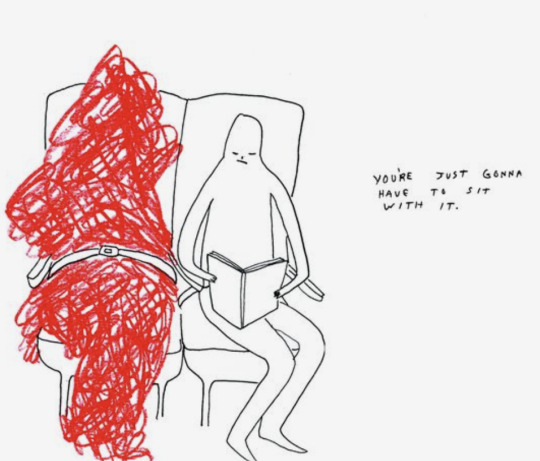
What do you value as a creative?
Cultural movement (Specifically Punjabi Sikh)
Mental Health
Feminism
Te Toi o Mangahekea, 2023
by tā moko and public installation artist Graham Tipene (Ngāti Whātua, Ngāti Kahu, Ngāti Hine, Ngāti Hauā, Ngāti Manu)
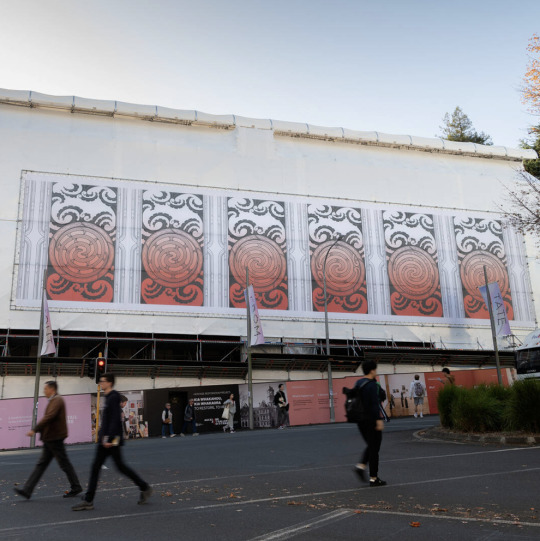
I can engage my curiosity on this by visiting this art gallery in person as this piece is outside AUT. I can go on their website and read the online website about it and the story to Graham Tipene’s thought process in designing this and what it actually means.
The values they bring into the work are
Inclusivity
Individualism
Passion
The design communities emerging from this piece are collectively from the Maori culture itself or people who didn’t know about their own native tongue but are relating to this piece on visually understanding more about their own homeland, as well as the diversed community surrounding this piece in New Zealand who have yet to start learning about it.
What excites me is how patterns can have such a deep meaning as well as the repetition in this particular piece and that it was outside the art gallery where I’m always walking past and there's no text to explain anything so that’s when you feel curious on wanting to know more to gain a better understanding.
The Creative
I am doing the creative practise and underpinning research and this can be approaching my work from different angles everyday and finding different solutions and problems to be working with, so I’m always staying curious and learning different ways of designing it.
I’m a designer who loves doing illustrations and working with type, if I ever get the chance to showcase my culture I love shining the light on it as everyday I learn more about it, and I feel like knowing my native language brings me closer to myself.
The influences on me as a designer come from many people, old traditions and stories within my own culture, influences with my peers in class and seeing the design directions where their work comes from, online research on worldwide people but mostly I like to choose categories of certain types of designs that I can intimately relate to.
I can unpack design ideologues by noting everything I've seen and what I want to believe in and what makes those designs visually relatable to me. It wouldn’t be my individual design piece if I never believed in it.
I can however expand my visual vocabulary by understanding the environmental, social, cultural and political context of my design influences as it’s not a trend and an ongoing discussion which can somehow correlate into my own work. I can always have another route by learning this way as I can explore and see how I respond to those pieces of work. I'll never know if I stick to the same comfort zone.
I value
Key themes, ideas and conversations in my work
0 notes
Text
Week 1
Creative, Creations and Creative communities.
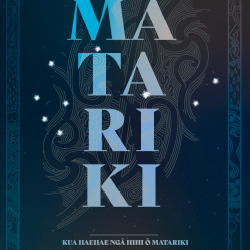

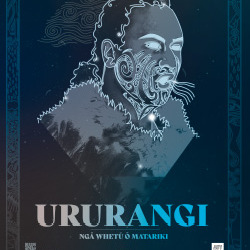
Introduction to lecturers and basic outlining of course content. The images above were shown as an example of work completed by another AUT student Hāriata Mann, the images were created to help educate and celebrate Matariki.



Above are images were also shown in class and were created by the artist Graham Tipene. The installation sits on the side of Auckland Art Gallery adjacent to AUT. Auckland Art gallery's description of the art work is
"Te Toi o Mangahekea, 2023 by tā moko and public installation artist Graham Tipene (Ngāti Whātua, Ngāti Kahu, Ngāti Hine, Ngāti Hauā, Ngāti Manu) draws on water for inspiration, acknowledging how integral it is to all life, and the many waters of Tāmaki Makaurau Auckland.
The six takarangi or interlocking spiral designs speak to the cyclical life of water, from sky to lake, to river, to sea, to sky. Tipene explains that they ‘represent male and female; Ranginui and Papatūānuku; the Waitematā and the Manukau, the two harbours surrounding the Gallery; and finally, east and west, the coastal waters, thereby covering the whole motu’.
Together these designs speak to the interconnectedness of the environment, and our duty of manaakitanga, or care, as kaitiaki, guardians. Commissioned for the Gallery’s heritage project, Kia Whakahou, Kia Whakaora (to restore, to heal) Te Toi o Mangahekea brings to mind the whakataukī ‘He taonga tuku iho nō ngā Tūpuna’ – ‘the treasures passed down from the ancestors’"
During the lecture, two Teaching Assistants (TA's) who were pursuing postgraduate studies were introduced. They shared their personal experiences at the Auckland University of Technology (AUT) and showcased their past work "What makes me Plastic", which had received a Gold accolade at the New Zealand Best Design Awards. Seeing how their processes for this project informed their decisions and how they used their life experiences to inform the outcome of their work was insightful for my own practice.
Some of the things I found interesting in their talk were
Project undertaken by a group of four Māori/Pasifika heritage students.
Common connection found to the "plastic" theme within their cultural context.
Extensive research conducted, including a survey with 200+ responses.
68% of Māori/Pasifika participants felt disassociated from their culture regarding "plastic."
Evolution from affirmation cards to photography as the design medium.
Design system marked by consistency: black background, portrait photos, white text.
Personalization: Participants freely hand-drew or wrote on their own portraits.
Innovative use of design: Transparent plastic overlays with handwritten messages and drawings in the publication.
Multifaceted perspective: Created through diverse range of questions experiences and provocation of thought.
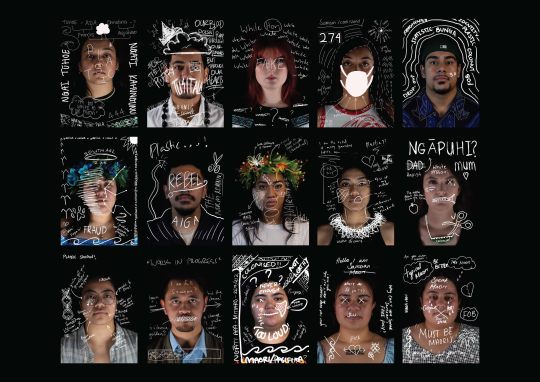
0 notes
Text
alam kong mali na biglang di ako nagparamdam, pero ang hirap lang na nangako ako na kahit ano need mo andito lang ako I realized a lot of things abt our relationship, di ko na maisa isa ang pinangako ko sayo kase alam mo na naman yan, nahihiya lang ako na sinanay kita sa mga bagay na di ko man pinagsisisihan pero di ko na kaya pa muli magawa yun, simula ngayon ang daming pagbabago na magkaroon na ako ng responsibilidad para sa pamilya at sarili ko, sinanay kita noon pero sa isang kibo di ako maaaring gumastos kase pano naman ako diba? pinipilit ko sarili ko na bumili ako ng ganto ganyan but I always think of u kase alam ko need moko e at yun e nagkukusa ako di ko sinasabi na ibalik mo sakin kase kahit anong pilit mo na ibalik di ko talaga tatanggapin yan kase di ako ganong tao e kilala moko kapag nagbigay ako, sorry halo halong emosyon nararamdaman ko, oo malungkot ako palagi kase alam mo ang unang rason pero sa patagal mas dumadami, sa trust mo sakin na kahit ilang beses ko paulit ulitin sayo na gusto ko sumaya kahit saglit, na sana naunawaan mo yon kase nadating sa puntong hirap na hirap ako hiling hili ako, siguro nga di moko maiintindihan kase di mo to ramdam e, wala akong mapagsabihan dito kase feel q e wala naman makakaintindi sakin, sorry nangako ako nagbitaw ako ng salita, siguro nga sanayin mo na sarili mo na ikaw na lang, sobrang bigat sa pakiramdam ko pero kailangan ko mamulat sa katotohanan na di pa dapat ako ganyan sayo e, masakit pero susubukan ko naman maging matapang, nahiya na lang ako kaya di aq nasagot sa calls chat and text mo, mahal kitaa mabuti kang tao walang makakapantay sayo, isipin mo na lang muna ay ung huling yakap ko sayo, sorry magiingat ka palagi mahal na mahal kita alam mo yan 🥺 intindihin mo sana ang isang katulad ko di ako perpekto pero gusto ko muna lumayo at sanayin sarili ko, ingat haa 😭 MAHAL KITA 💛
0 notes
Text
I couldn't find a nice (read: any) list anywhere, so I've been compiling one. I've. watched a lot of 1.0 videos. Anyway I'm going to keep them in one big post chain for reference. If you know where more descriptions are, please let me know!
As far as I can tell, each Parley usually has 8 or 9 tiles. I did notice two sets with only 8, which could be a function of a ninth tile existing but not showing up. I also noted one set that had 10 tile topics - this seemed to be because a special tile was added that was related to the specific quest.
These are in no particular order, and are largely but not always the order in which I got a look at the description text.
Parley Tile Descriptions for DoH/DoL Rank Quests 20, 30, and 36
It seems like most classes had a parley required in the R30 class. Fisher is distinct in that, at least in the videos I looked at, there was no parley in any of them. Goldsmith and Leatherworker had multiple rank quests with parleys and Weaver* had multiple parleys in one rank quest.
While I saw both an Ul’dah specific topic paired with the Ul’dah flag, and a Gridanian topic and flag, I did not see a Limsa Lominsan one.
Descriptions are only listed once per item.
*another class had this situation but I can’t remember if its Armorer/Blacksmith, or if its Miner. My head is MUSH rn.
Alchemist R30 (No R20/R36)
gil
-the gil icon
debilitating powders
-acidic/vicious secretions
medicinal reagents
-clear vial with a cork stopper
ill-boding reptilian wings
-looks like a puk wing, ironically enough
a novice’s alembic failure
-a black/brown metal alembic
the taste of potions
-a max potion
alchemists
-the alchemist job icon in yellow
Ul’dahn history
-Ul’dahn flag, squared
Armorer/Blacksmith R30
razor-sharp arrowheads
-a row of three arrowheads
the ring of a doming hammer
-a doming hammer (not bronze)
crude bronze squares
-copper plate
blacksmiths OR armorers (depends on PC's active class AFAICT)
-blacksmith OR armorer job icon in yellow
Ul'dahic history (*this spelling appears in multiple parleys, and I believe was changed sometime between 2010 and 2012 to Ul'dahn history)
a cross-pein hammer accident
-bronze colored cross-pein hammer
miners
-miner job icon in yellow
effective pickaxes
-a dark colored metal standard pickaxe
gil
Botanist R30
Gridanian lore
-the Gridianian flag, squared
a secret cotton field
-a cotton boll
gil
unusual lauan logs
-a log, presumably lauan
a hatchet forgotten in the forest
-a bronze-colored hatchet
botanists
-the botanist job icon in yellow
strange moko grass
-perfectly normal moko grass
Carpenter R30
techniques for working lauan logs
-lumber
archers
-the archer job icon in yellow
a mysterious square shield
-square maple shield
popular spear shafts
-looks like a very smooth stick
Gridanian lore
durable willow planks
-a brown plank icon
a blood-stained weathered saw
-a weathered saw
carpenters
-the carpenter job icon in yellow
Culinarian R30
stylish needles
-a sidewise-turned needle in the style of the Artisan’s needle, albeit with a rose icon.
Ul’dahn history
culinarians
-culinarian job icon in yellow
cheap miq’abobs
-a miq’abob
weavers
-weavers job icon in yellow
a legendary skillet
-a bronze-colored skillet
scrumptious omeletts
-omelette icon
Goldsmith SHARED BY ALL RANK QUESTS
goldsmiths
-goldsmith job icon in yellow
sunstone-related rumors
-sunstone
tricks to using chase hammers (this does say chase, not chaser)
-a black-colored metal chaser hammer
a gift choker
-a copper choker
an unremoveable copper ring
-a copper ring
an unearthed raw sunstone
-raw sunstone
Goldsmith R20 Specific
Ul’dahic history (see previous Ul’dahic history entry)
miners
effective pickaxes
Goldsmith R30 Specific
the moogle’s favorite flowerbeds
-a strange brown flower with two leaves. Looks a bit like a pearl roselle but not.
Gridanian lore
Goldsmith R36 Specific
gil
Gridanian lore (an aside: this quest appears to be in Ul’dah during this parely)
Leatherworker SHARED BY ALL RANK QUESTS
the tanning of karakul skins
-karakul skin
a clean cutting head knife (completely unimportant aside, I can’t tell if this is a cutting head knife that is clean, or a knife head that is clean-cutting)
-a head knife that looks not quite bronze nor brass, but shares that model.
a fragrant pair of gloves
-these look like Vintage Smithy's Gloves to me
leatherworkers
-leatherworker job icon in yellow
a clumsy jacket
-some sort of long-sleeve shirt made of one single color. Looks like brown leather.
a technique using sheep leather spetches
-looks like the icon for flannel, but brown
R30 Specific
gil
Ul’dahn history
R36 Specific
gladiators
-the gladiator job icon in yellow
a cursed gladius
-I did not record this icon apparently. It was a sword of some kind. Probably a gladius.
Gridanian lore
Miner R30
the copper ore market
-copper ore
miners
Ul’dahn history
a synthesis using brimstone
-brimstone icon
tin ore mines
-tin ore
a worn-out shortbow
-weathered shortbow
effective pickaxes
archers
-the archer job icon in yellow
Weaver R30 SHARED BY ALL PARLEY INSTANCES
Theldry’s shop
-a black and white striped hide/skin circle
rare cloth spetches
-flannel icon
weavers
an immensely popular hunting tunic
-looks like a tunic mixed with a haubergeon
stylish needles
high-quality hempen cloth
-a beige roll of cloth that is absolutely in no way whatsoever hempen cloth
Weaver R30 p1
Ul’dahn history
botanists
a hatchet forgotten in the forest
Weaver R30 p2
Ul’dahn history
carpenters
a blood-stained weathered saw
a life-saving coif
-hempen coif of gathering
Weaver R30 p3
a worn-out shortbow
Weaver R30 p4
a life-saving coif
Ul’dahn history
gil
------------------------
There are 89 instances of topics including duplicates. After removing duplicates, there are 60. There are as follows alphabetically, excluding 'a' and 'an':
alchemists
archers
armorers
blacksmiths
blood-stained weathered saw
botanists
carpenters
cheap miq’abobs
clean cutting head knife
clumsy jacket
cross-pein hammer accident
crude bronze squares
culinarians
cursed gladius
debilitating powders
durable willow planks
effective pickaxes
fragrant pair of gloves
gift choker
gil
gladiators
goldsmiths
Gridanian lore
hatchet forgotten in the forest
high-quality hempen cloth
ill-boding reptilian wings
immensely popular hunting tunic
leatherworkers
legendary skillet
life-saving coif
medicinal reagents
miners
mysterious square shield
novice’s alembic failure
popular spear shafts
rare cloth spetches
razor-sharp arrowheads
scrumptious omeletts
secret cotton field
strange moko grass
stylish needles
sunstone-related rumors
synthesis using brimstone
technique using sheep leather spetches
techniques for working lauan logs
the copper ore market
the moogle’s favorite flowerbeds
the ring of doming hammer
the tanning of karakul skins
the taste of potions
Theldry’s shop
tin ore mines
tricks to using chase hammers
Ul’dahic history
Ul’dahn history/ul'dahic history
unearthed raw sunstone
unremoveable copper ring
unusual lauan logs
weavers
worn-out shortbow
#long post#ffxiv#ffxiv 1.0#parley#if there are any errors sorry ive been listening to two songs at the same time for the past couple hours and also. its parley.#it seems designed to melt your brain#i love it but.
0 notes